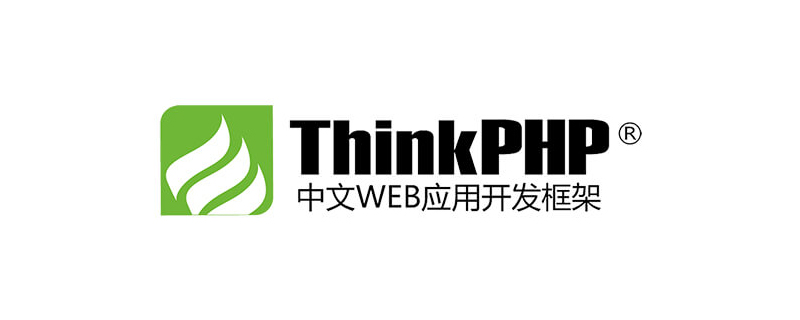With the rapid development of mobile Internet and the popularity of cloud computing, Web services (especially RESTful API) have become the most important part of the current development field. So how to use ThinkPHP6 for RESTful API testing? This article will provide a detailed introduction to RESTful API testing methods in ThinkPHP6 as well as recommended tools and practices.
- Environment setup
First, you need to install the ThinkPHP6 environment, which can be installed using the composer provided on the official website. Enter the following command in the command line window:
composer create-project topthink/think tp6
Then, create the .env file in the project root directory, in which you need to add the database configuration:
DB_HOST = localhost DB_NAME = test DB_USER = root DB_PASSWORD =
- Route definition
In ThinkPHP6, we can use the Route::rule method to define routes, for example:
Route::rule('users', 'apppicontrollerUser');Among them, users is our customized URI path, app picontrollerUser is the corresponding controller.
- Writing Controller
In ThinkPHP6, we can handle RESTful API requests through the controller (Controller). The following is a simple controller code:
<?php
namespace apppicontroller;
use think
acadeDb;
class User
{
public function index()
{
return json(Db::table('users')->select());
}
public function read($id)
{
return json(Db::table('users')->where('id', $id)->find());
}
public function save()
{
$data = input();
Db::table('users')->insert($data);
return json(['msg' => 'created']);
}
public function update($id)
{
$data = input();
Db::table('users')->where('id', $id)->update($data);
return json(['msg' => 'updated']);
}
public function delete($id)
{
Db::table('users')->where('id', $id)->delete();
return json(['msg' => 'deleted']);
}
}In this controller, we define index, read, save, # The five methods ##update and delete respectively correspond to the five methods in the RESTful API: GET, GET, POST, PUT and DELETE.
- Testing Tools
- Practical Case
http://localhost/api/users
GET
200
json
[
{
"id": 1,
"name": "Tom",
"email": "tom@example.com"
},
{
"id": 2,
"name": "Jerry",
"email": "jerry@example.com"
}
]5.2 HTTP POST requestURI: http://localhost/api/users
POST
form-data
| Parameter value | |
|---|---|
| Mary | |
| mary@example.com |
201
json
{
"msg": "created"
}5.3 HTTP PUT request URI:http://localhost/api/users/3
PUT
x-www-form- urlencoded
| Parameter value | |
|---|---|
| John | |
| john@example.com |
200
json
{
"msg": "updated"
}5.4 HTTP DELETE requestURI : http://localhost/api/users/3
DELETE
200
json
{
"msg": "deleted"
}
- Summary
The above is the detailed content of How to use ThinkPHP6 for RESTful API testing?. For more information, please follow other related articles on the PHP Chinese website!
 thinkphp是不是国产框架Sep 26, 2022 pm 05:11 PM
thinkphp是不是国产框架Sep 26, 2022 pm 05:11 PMthinkphp是国产框架。ThinkPHP是一个快速、兼容而且简单的轻量级国产PHP开发框架,是为了简化企业级应用开发和敏捷WEB应用开发而诞生的。ThinkPHP从诞生以来一直秉承简洁实用的设计原则,在保持出色的性能和至简的代码的同时,也注重易用性。
 一起聊聊thinkphp6使用think-queue实现普通队列和延迟队列Apr 20, 2022 pm 01:07 PM
一起聊聊thinkphp6使用think-queue实现普通队列和延迟队列Apr 20, 2022 pm 01:07 PM本篇文章给大家带来了关于thinkphp的相关知识,其中主要介绍了关于使用think-queue来实现普通队列和延迟队列的相关内容,think-queue是thinkphp官方提供的一个消息队列服务,下面一起来看一下,希望对大家有帮助。
 thinkphp的mvc分别指什么Jun 21, 2022 am 11:11 AM
thinkphp的mvc分别指什么Jun 21, 2022 am 11:11 AMthinkphp基于的mvc分别是指:1、m是model的缩写,表示模型,用于数据处理;2、v是view的缩写,表示视图,由View类和模板文件组成;3、c是controller的缩写,表示控制器,用于逻辑处理。mvc设计模式是一种编程思想,是一种将应用程序的逻辑层和表现层进行分离的方法。
 实例详解thinkphp6使用jwt认证Jun 24, 2022 pm 12:57 PM
实例详解thinkphp6使用jwt认证Jun 24, 2022 pm 12:57 PM本篇文章给大家带来了关于thinkphp的相关知识,其中主要介绍了使用jwt认证的问题,下面一起来看一下,希望对大家有帮助。
 thinkphp扩展插件有哪些Jun 13, 2022 pm 05:45 PM
thinkphp扩展插件有哪些Jun 13, 2022 pm 05:45 PMthinkphp扩展有:1、think-migration,是一种数据库迁移工具;2、think-orm,是一种ORM类库扩展;3、think-oracle,是一种Oracle驱动扩展;4、think-mongo,一种MongoDb扩展;5、think-soar,一种SQL语句优化扩展;6、porter,一种数据库管理工具;7、tp-jwt-auth,一个jwt身份验证扩展包。
 一文教你ThinkPHP使用think-queue实现redis消息队列Jun 28, 2022 pm 03:33 PM
一文教你ThinkPHP使用think-queue实现redis消息队列Jun 28, 2022 pm 03:33 PM本篇文章给大家带来了关于ThinkPHP的相关知识,其中主要整理了使用think-queue实现redis消息队列的相关问题,下面一起来看一下,希望对大家有帮助。
 thinkphp 怎么查询库是否存在Dec 05, 2022 am 09:40 AM
thinkphp 怎么查询库是否存在Dec 05, 2022 am 09:40 AMthinkphp查询库是否存在的方法:1、打开相应的tp文件;2、通过“ $isTable=db()->query('SHOW TABLES LIKE '."'".$data['table_name']."'");if($isTable){...}else{...}”方式验证表是否存在即可。
 thinkphp3.2怎么关闭调试模式Apr 25, 2022 am 10:13 AM
thinkphp3.2怎么关闭调试模式Apr 25, 2022 am 10:13 AM在thinkphp3.2中,可以利用define关闭调试模式,该标签用于变量和常量的定义,将入口文件中定义调试模式设为FALSE即可,语法为“define('APP_DEBUG', false);”;开启调试模式将参数值设置为true即可。


Hot AI Tools

Undresser.AI Undress
AI-powered app for creating realistic nude photos

AI Clothes Remover
Online AI tool for removing clothes from photos.

Undress AI Tool
Undress images for free

Clothoff.io
AI clothes remover

AI Hentai Generator
Generate AI Hentai for free.

Hot Article

Hot Tools

SublimeText3 Mac version
God-level code editing software (SublimeText3)

MantisBT
Mantis is an easy-to-deploy web-based defect tracking tool designed to aid in product defect tracking. It requires PHP, MySQL and a web server. Check out our demo and hosting services.

MinGW - Minimalist GNU for Windows
This project is in the process of being migrated to osdn.net/projects/mingw, you can continue to follow us there. MinGW: A native Windows port of the GNU Compiler Collection (GCC), freely distributable import libraries and header files for building native Windows applications; includes extensions to the MSVC runtime to support C99 functionality. All MinGW software can run on 64-bit Windows platforms.

WebStorm Mac version
Useful JavaScript development tools

Safe Exam Browser
Safe Exam Browser is a secure browser environment for taking online exams securely. This software turns any computer into a secure workstation. It controls access to any utility and prevents students from using unauthorized resources.






